commentary Commentary
Commentary: Can farming be a success story for Singapore?
It would be a shame if farms in Singapore are valued only for their economic production, because they have potential to be a success story for Singapore, says Kranji Countryside Association president Kenny Eng.
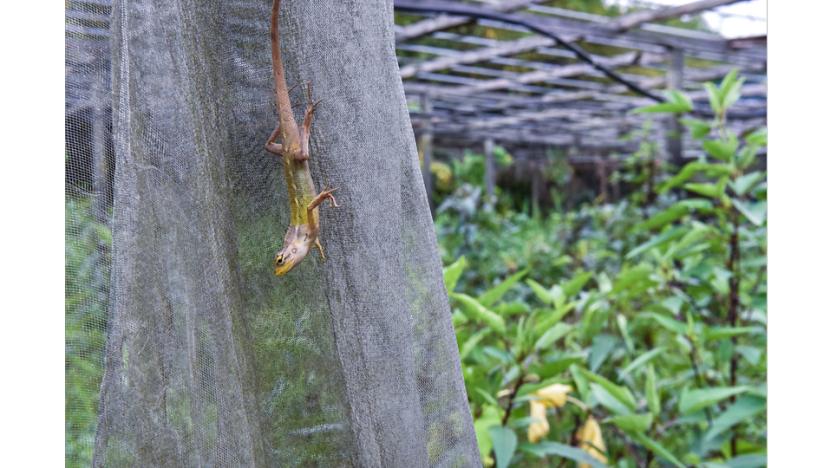
A lizard forming part of the ecosystem at Fire Flies organic vegetable farm (Photo: Justin Ong)
SINGAPORE: I read with interest the Government’s plan to transform the farming sector in Singapore last week. It had key strategies we expected to see: overcoming space constraints with technology, using resources more efficiently and developing a generation of “agri-specialists”.
I was hopeful because it showed us that agriculture is getting increased policy attention, and symbolised a growing recognition that despite being a city-state, Singapore must take growing some of its own food seriously.
The farming transformation map identified many technologies that farms can look to to increase productivity: vertical farming, climate-controlled systems and robotics to name a few. Indeed, for a small market that imports 90 per cent of our food, Singapore’s food supply can be threatened by climate change and geopolitical uncertainties, and technology can be one answer. Developing strong local capabilities in agriculture at this stage in the game may be a belated move, but better late than never.
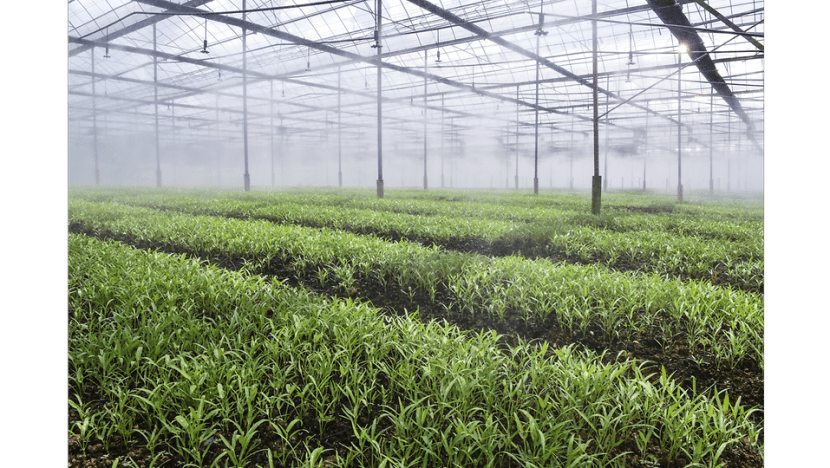
Kangkong crops grow in Yili vegetable farm
The Government also rightly pointed out that skilled workers would need to support this effort. So engineers, architects, researchers and entrepreneurs should all be co-opted into building Singapore’s farming and food future.
However, the farming transformation map was also a missed opportunity to address inherent problems and wider possibilities of our agricultural sector. There was a strong focus on scarcity and intensification, but more can be done to connect the dots of a natural and social ecosystem and more holistically develop the agricultural sector.
I wish I could say that we will be able to easily transform our agriculture sector into one with high-tech, productive and profitable farms envisaged, but we have to ask ourselves some hard questions first.
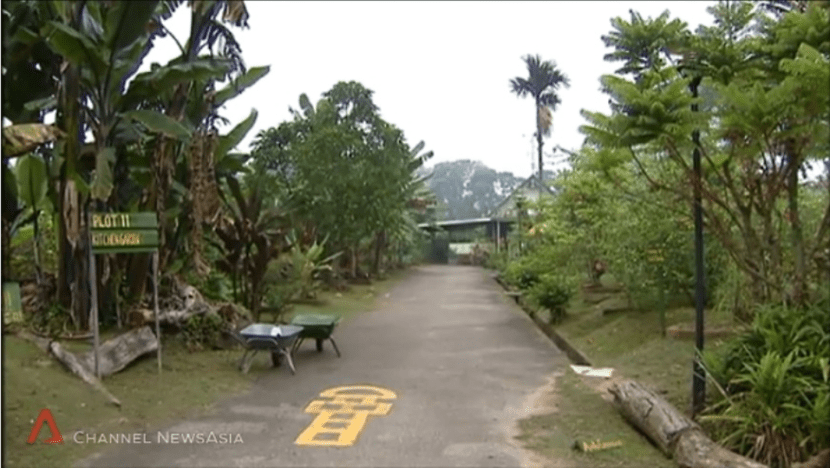
A road leads vistors to Kranji countryside farms.
First, are farmers able to adopt technology, and why or why not? The trouble is that agricultural technologies have not taken off in Singapore because of underlying business factors. High risks, lack of financing and limited farm tenures hold us back. A 30 per cent upfront government grant to buy a machine or install a system does not fundamentally address common challenges faced by the local farmer of having no money for basic infrastructure, no assurance that his farm is on ground protected for agriculture and few talent joining the industry. As production capabilities are inextricably linked to business prospects, the farm transformation map may be asking farmers to fly before they even walk.
Second, are we measuring the right outcomes? Although “people development” and “multi-disciplinary expertise” were mentioned in the roadmap, they still only refer to people and expertise that support intensification. Yet agriculture’s success surely cannot be defined solely by yields – farming and related enterprises have intrinsic value for education, tourism, community and nation building. In these important aspects that add immeasurable value to primary production, the transformation map misses the mark.
AGRICULTURE'S IMPORTANCE TO SINGAPORE
Agriculture is one of humankind’s oldest pursuits and one that enabled civilisation to thrive.
Singapore, like inhabited lands across the world, was once an agrarian society that produced nearly all our own food. Orchard Road was a gambier plantation, Punggol had pig farms and every kampong had free range chickens and organic vegetables. At our independence in 1965, we produced 60 per cent of our own vegetable demand, 80 per cent of poultry, 100 per cent of eggs and even exported pork. We published a farming journal and even organised a large agricultural show attended by the late founding Prime Minister Mr Lee Kuan Yew in 1965.
In our quest for economic growth, rapid industrialisation was achieved at the expense of small farms that were gradually phased out. By 2014, only one per cent of land – most of which were located within the Kranji countryside – was used for agriculture. 62 farms will be relocating in 2019 to make way for defence training grounds. Depending on the land size farmers will be given, this move may shrink agricultural land to 0.5 per cent. And efforts to develop the sector are still very much focused on achieving the goals of land intensification and primary production.
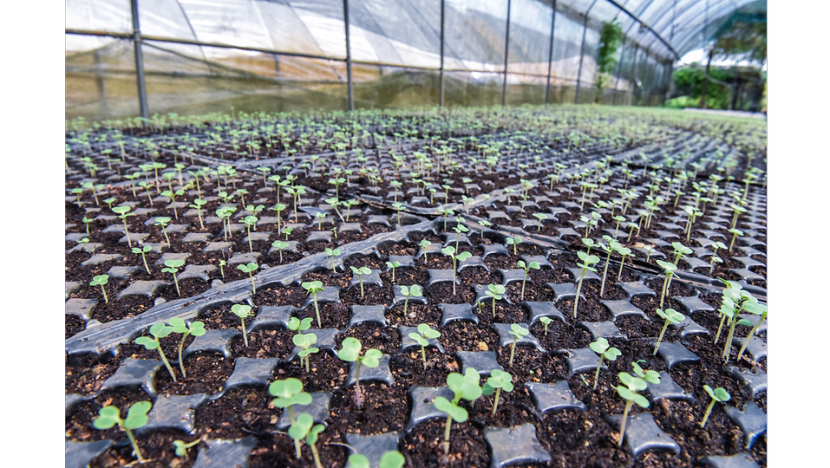
Kai-lan seedlings thrive well at Fire Flies organic vegetables farm
There is some background to this focus. The global food crisis in 2007 that led to a 12 per cent increase in prices of Singapore’s food imports may have marked a first turning point in the Government’s policies on agriculture – giving urgency to shore up Singapore’s self-sufficiency in core food items to buffer against supply shocks. Given a context of land scarcity and urban pressures, it is no wonder that intensification of primary production seemed to have become the key priority for Singapore’s agricultural sector.
Yet, there is much to be done to marry policy intent and ground realities. Unlike other sectors in Singapore with long-term policy, infrastructure and other forms of support, farms do not have a sound enough business footing to invest heavily in expensive and unproven technology. They also have short land leases, making it harder for returns on investment to be worthwhile.
Farmers also say that while increasing support for the core food items of vegetables, eggs and fish has helped many of them, it leaves out others who produce nutritious and safe food for Singapore and are equally deserving of assistance. Indigenous root vegetables, fruits and herbs, goat’s milk and frog meat are some examples.
In an age of climate uncertainty and rapid urbanisation, there may be merits to protecting indigenous agriculture and farmers’ livelihoods. For as long as we turn to the land rather than labs for food, agriculture should be taken seriously as an industry and rendered the appropriate support as the sector faces new challenges.
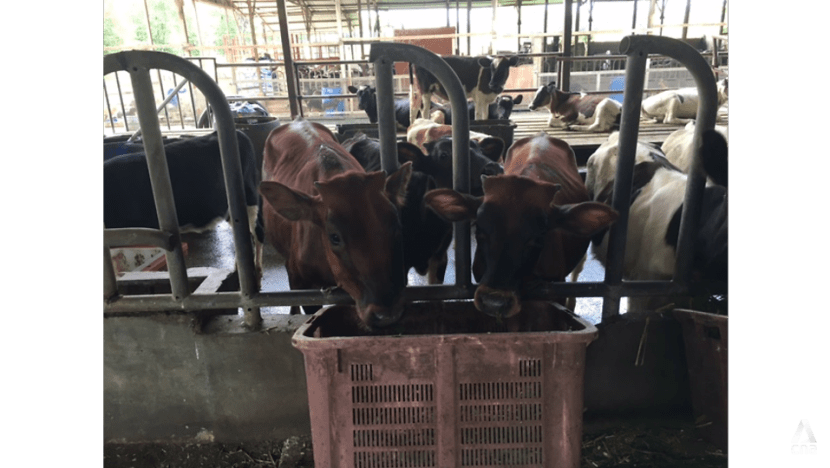
A dairy farm in the Kranji countryside. (Photo: CNA)
Models of development surrounding farming have changed drastically in the last decades. While higher productivity and yields were achieved through land intensification and industrial farming methods of Green Revolution in the 1960s and 70s, many of these developments have reached a plateau because of soil and environmental degradation.
But there is more to be optimistic about, if we decide to invest seriously into this sector. The new waves of agricultural thought now encompass not only the higher end of biotechnology such as gene editing, but also simply going back to basics, creating a healthy environmental ecosystem for crops and livestock, and letting nature take its grand course. Importantly, agricultural thought leadership embraces inclusiveness: uplifting smallholder farms, giving them reasons to stay on their land and raising awareness of rural lifestyles to increasingly urban populations.
If Singapore is to be serious about farming, seeing it not as just as a possible economic engine but a sector with potential for innovation and lifestyle transformation, then we need a new approach now – one with a more rounded development trajectory for the local agricultural industry. We can take a wait-and-see approach. But if we do so, it is likely that 50 years from now, the natural and indeed the social ecosystem of farms in our present countryside would be long gone and rebuilding it organically would be close to impossible.

A worker doing a routine check on the vegetable crops at a farm in Singapore. (Photo: AFP)
A DIFFERENT DEVELOPMENT TRAJECTORY: TRANSFORMING SINGAPORE'S COUNTRYSIDE
As early as 2004, some of us in Kranji were already looking at a different development model. Farmers themselves were acutely aware of the need to innovate and change their business models to remain relevant and viable in a city-state where land and labour is expensive. So we looked to other countries and found that small farms at the fringes of cities, also known as peri-urban farms, made use of their proximity to urban populations to offer services and experiences beyond primary production.
We got rules for farms changed so that farmers could build education centres, museums, cafes and farmstays on their premises. These amenities were never intended to replace primary production but to enhance and preserve farms, and to give the farming cluster new life as a lifestyle destination.
Bed and breakfasts and vineyards in the countrysides of developed nations provided good referenced, but Singapore has an even more attractive proposition: Kranji is only 30 minutes away from the city, with different types of farms co-existing. It is also just a stone’s throw from the historic Kranji War Memorial and Sungei Buloh Wetland Reserve, and safe under the watch of our nearby defence forces.
It is a gem of an ecosystem, and should be protected and developed as a national treasure. Countries that have protected their peri-urban areas, such as the Netherlands, Japan and Australia, are far ahead in food security than others who have not, such as India, Myanmar and Indonesia.

The Kranji Countryside Farmers' Market held each quarter draws crowds of people, including many families and local resident communities. (Photo: Kranji Countryside Farmers' Market)
Many of us in Kranji have always held the view that the last one per cent of land used for agriculture must achieve multiple goals and not just that of primary production. Visitors to Kranji can testify that local farms have continuously evolved through innovation. The introduction of enterprise, value creation and destination marketing strategies into traditional farming business models have enabled us to achieve higher productivity and commercial viability while creating good jobs and contributing to the larger Singaporean community.
In a way, maybe innovation does not always need to involve adopting the latest production technology in farming – it should also encompass artisanal processing, visitor experience and concept innovation. There have been companies that evolved their plant nursery businesses to landscape and events companies offering naturally inspired lifestyles. And in Kranji, we focused on developing the countryside, which contains the ecosystem in which the industry thrives - running a private shuttle bus service to farms and getting installed a directional sign for Kranji farms that identified the area as a tourist destination.
Visitors to the Kranji countryside now total more than 20,000 each month. This tell me that such forms of innovation drive demand in our digital age and city, which in turn generates revenue and investment for building core capabilities.
GOVERNMENT AND COMMUNITIES AS ENABLERS
Agricultural businesses in Singapore need to capture value where they can and work together with the government and community to grow multi-dimensionally. With the help of government agencies such as the Agri-Food and Veterinary Authority of Singapore (AVA), SPRING and Singapore Tourism Board (STB), many farms have indeed upgraded their capabilities and offerings in the last decade.
AVA’s support enabled the first hydraulic vertical vegetable growing system developed by local farm Skygreens to open its doors in 2011. SPRING’s grants helped our egg farmers purchase much needed labour-saving and processing technologies. As a result, egg productivity increased over the past five years. STB supported the first ever Go-local campaign in 2009 and subsequently the 27th Commonwealth Agriculture Conference that saw 300 international delegates visit our tiny countryside in 2016. Throughout the years, it has also introduced many foreign journalists to the area and the result is more tourist interest in our local farms.
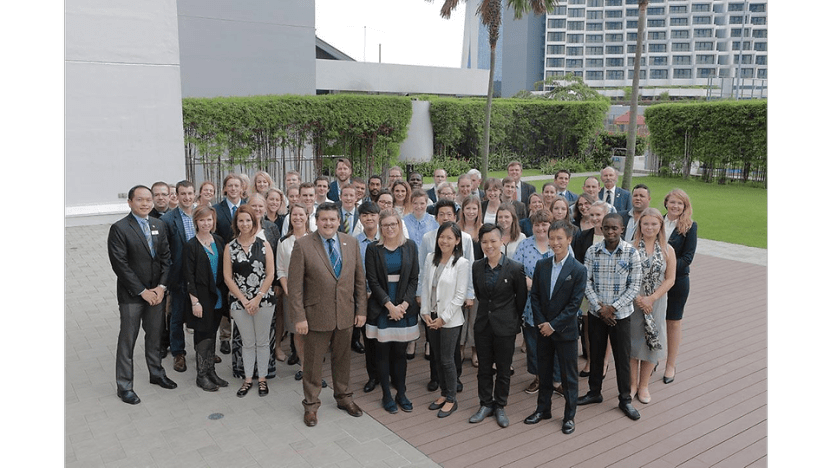
The 27th Commonwealth Agricultural Conference held in November 2016 brought together 300 agricultural businesses and thought leaders from around the world. (Photo: Kranji Countryside Association/Facebook)
The community has also played an important role in the countryside’s transformation. When we launched the first Kranji Countryside Farmers’ Market in 2014, 4,000 people showed up and wiped out limited stocks in two hours. Nearly three years down the road and into its ninth edition, the quarterly event now attracts 12,000 people who see the value in knowing the farmers who produce their food and bringing their families to the countryside for a day out.
The community has been vocal in supporting the preservation of farms as many share the view that Singapore’s farms have an intrinsic value for national education, conservation and tourism. Many people who I have talked to also say they see the countryside as an inalienable part of Singapore’s heritage and nation building.
CAN FARMS AND OUR COUNTRYSIDE SURVIVE?
I distinctly remember, nine years ago, addressing an auditorium full of young farmers from around the Commonwealth on value creation for smallholder farms. Facing farmers who own thousands of hectares of land and businesses worth millions, I thought I would be laughed at when I highlighted how Singapore’s farms hope to diversify their income, build a brand and attract young talent.
Instead, many young farmers told me that they knew deep in their bones this direction is the future of agriculture. In a primary industry of diminishing margins and rising costs and risks, reinvention is necessary. The reinvention the brightest minds in farming talk about has more to do with human ingenuity, resilience and creativity than any technology silver bullets.

Hay Dairies farm owner John Hay holds up a baby goat at his farm
Can farms and our countryside survive in the global city of Singapore? Having grown accustomed to their lonely struggles, farmers in Singapore today are heartened by the growing awareness and support of the industry, though the future still looks uncertain.
We hope for a bolder and more balanced transformation map, and one that recognises the intrinsic value the farming community captures for Singapore and Singaporeans – in heritage, education and promoting a sustainable and green way of life. We know the community behind us grows. And we hope that despite being the underdog of the economy, we can be another one of Singapore’s softer success stories.
It would be a shame if we were valued solely for our economic production.
Kenny Eng is president of the Kranji Countryside Association, a non-profit organisation founded in 2005 that promotes local agriculture, food security and sustainability.














